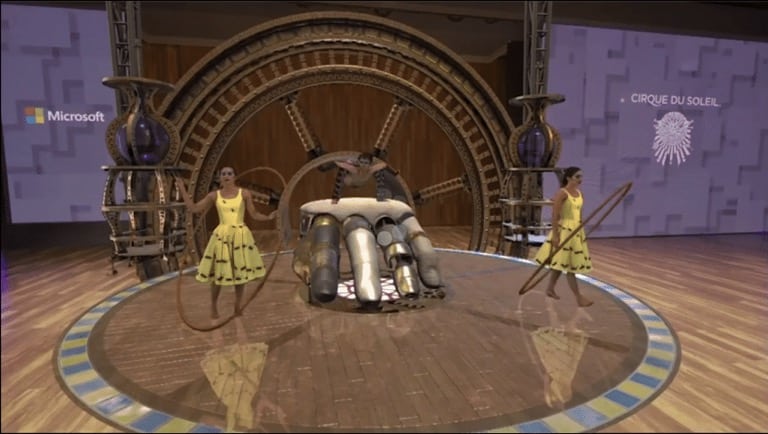Thinking of Microsoft HoloLens and Mixed Reality often brings me back to my childhood. Remembering how the worn-out toys in my hands could be quickly transformed in my imagination into shapes and colors to transport me from the floor of my room to magical worlds. Little did I know that in my very lifetime I will see these tools come to life.
HoloLens is not perfect and in many ways still leaves me asking for more. But it certainly excites me every time I wear it. I still think of it as a work in progress but the Microsoft team deserves credit of getting us all to play in mixed reality.
At the Microsoft Build conference, Alex Kipman introduced Microsoft’s latest HoloLens collaboration with Cirque du Soleil secretive C-Lab. This is not the first time the Cirque has stepped into new media arena. Last year the Canadian Felix & Paul studios released a VR piece that remains one of my favorite VR experiences.
On stage Kipman and the Cirque du Soleil team walked us through the intricate process of stage design. The global entertainment giant is the largest theatrical producer in the world. It’s an incredibly complex and deeply collaborative 18 month process that they undertake for every one of their productions.
You can see from the video below how it came together. Roughing out the shapes, adding details, and bringing in staff from overseas transforms the design process.
Microsoft HoloLens and creatives
Now let’s unpack this a little. Microsoft has been trying to position and present their tech in the space of creative work. They could have easily brought in some of the architecture studios that have been making good use of the HoloLens in visualizing interior and exterior design. Yet, putting the HoloLens in the hands of creative designers is when the magic truly begins to happen.
Keep in mind that the video you see maximizes the field of view compared to what you actually see using the device. But the limited field of view in HoloLens is still far better than any tool you will use on your screen. The video above gives you the view from the perspective of wearing the headset but obscures the narrow angle. Yet, it shows how you can use new tools to create and design in VR and MR.
Microsoft HoloLens tools
On stage the Cirque du Soleil team showcased the new collaboration tools for the work they do with the Microsoft HoloLens. In bringing in a designer from Europe through a hologram, they demoed how HoloLens will work with the forthcoming Microsoft VR headsets and new Motion Controllers. The design tools worked seamlessly on both HoloLens which uses gestures and the new Microsoft VR headset with the controllers. These two different devices could become the basis for a powerful collaborative platform.
In addition, on screen you can see the interface of the design tools as the team create and co-create the new set. It is wonderful to see things built in 3D. The interfaces were close to what we have seen in similar tools on the HTC Vive. The application of these MR tools are easily transferable to a whole host of industries from industrial design to education.
It was interesting to also observe the voice commands in the design process. IBM showcased a few voice controlled VR experiences at SXSWedu and this certainly opens the potential to use HoloLens in creative process by almost anyone.
Performance is immersive in all its forms
In the final part of the demo we saw a nearly complete stage set with performers and music playing in the background. The music immediately pulls you in – once again reaffirming how important audio is to immersive experiences. I loved seeing how the stage set idea emerged through the HoleLens. The designer in me completely geeks out – seeing the design process actually brings you closer to the performance.
For now, we’re hoping to see more from the Microsoft HoloLens and Cirque du Soleil collaboration. And most important, we’re looking forward to seeing collaboration across different devices. It is essential for the future of immersive technologies.

Maya Georgieva is an EdTech and XR strategist, futurist and speaker with more than 15 years of experience in higher education and global education policy. Her most recent work focuses on innovation, VR/AR and Immersive storytelling, design and digital strategy. Maya actively writes and speaks on the topics of innovation, immersive storytelling and the future of education and consults organizations and startups in this space.

